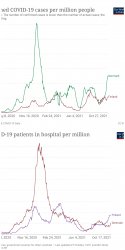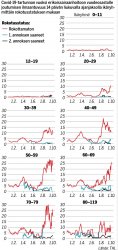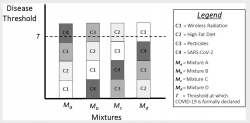Lähes satavarmasti vaan mukavuudenhalua. Ei tuollaisella osastonhoitajalla mitään sellaista budjettivastuuta ole, että sen pitäisi rahan kautta miettiä äitiyslomia. Mutta kauheastihan tuosta on vaivaa. Julkisella sektorilla kun saa saman palkan näkemättä vaivaa, niin kukaan ei jaksa nähdä vaivaa tai yrittää liikoja. Sama ilmiö selittää osin myös hoitajien pahoinvointia.Luultavasti yhdistelmä tulospaineita ja omaa mukavuudenhalua. Välipomo näkee heti, että tälle pitää kohta ettiä sijaista samaan aikaan kun osa budjetista juoksee silti tän tilille. Laitonta toki mutta jos rahaa olisi käytettävissä, tuskin olisi tarvetta moiselle.
-
PikanavigaatioAjankohtaista io-tech.fi uutiset Uutisia lyhyesti Muu uutiskeskustelu io-tech.fi artikkelit io-techin Youtube-videot Palaute, tiedotukset ja arvonnat
Tietotekniikka Prosessorit, ylikellotus, emolevyt ja muistit Näytönohjaimet Tallennus Kotelot ja virtalähteet Jäähdytys Konepaketit Kannettavat tietokoneet Buildit, setupit, kotelomodifikaatiot & DIY Oheislaitteet ja muut PC-komponentit
Tekniikkakeskustelut Ongelmat Yleinen rautakeskustelu Älypuhelimet, tabletit, älykellot ja muu mobiili Viihde-elektroniikka, audio ja kamerat Elektroniikka, rakentelu ja muut DIY-projektit Internet, tietoliikenne ja tietoturva Käyttäjien omat tuotetestit
Softakeskustelut Pelit, PC-pelaaminen ja pelikonsolit Ohjelmointi, pelikehitys ja muu sovelluskehitys Yleinen ohjelmistokeskustelu Testiohjelmat ja -tulokset
Muut keskustelut Autot ja liikenne Urheilu TV- & nettisarjat, elokuvat ja musiikki Ruoka & juoma Koti ja asuminen Yleistä keskustelua Politiikka ja yhteiskunta Hyvät tarjoukset Tekniikkatarjoukset Pelitarjoukset Ruoka- ja taloustarviketarjoukset Muut tarjoukset Black Friday 2025 -tarjoukset
Kauppa-alue
Navigation
Install the app
How to install the app on iOS
Follow along with the video below to see how to install our site as a web app on your home screen.
Huomio: This feature may not be available in some browsers.
Lisää vaihtoehtoja
Tyylin valinta
You are using an out of date browser. It may not display this or other websites correctly.
You should upgrade or use an alternative browser.
You should upgrade or use an alternative browser.
Koronavirus SARS-CoV-2 ja sen aiheuttama tauti COVID-19 (Yleinen keskustelu)
- Keskustelun aloittaja Zezekärppänen
- Aloitettu
- Liittynyt
- 19.10.2016
- Viestejä
- 4 565
Monikin järjestelmä on turvallinen, vaikka niitä käyttää ihmiset. Täytyy vaan pitää huoli, että se ihmisen käyttäytyminen on otettu huomioon asian vakavuuden vaatimalla tavalla. Jopa NSA:ssa on käynyt niin, että tietoja vuodettiin ihmisen toimesta, vaikka hänelle oli tehty tarkimmat taustaselvitykset ja jopa valheenpaljastuskokeet (omien sanojen mukaan). Ihmisen käyttäytyminen voidaan ottaa huomioon vaikkapa varautumissuunnitelmilla. Lisää tietoturvasta löydät esim. täältä Etusivu | Kyberturvallisuuskeskus
Voisiko tätä turhaa lässytystä aiheen vierestä muka-asiantuntijana aiheesta mistä et selvästikään tiedä mitään tai muuten syystä x kommentoit aiheen vierestä ja ketjuun postatun oikean tiedon (TM)* vastaisesti jättää vähemmälle?
* Käytän tässä termiä väljästi, en tarkoita anekdooteista vääristeltyjä johtopäätöksiä.
Käydäänpä tätä koronapassin käyttämään digitaalista allekirjoitusta ja siihen liittyviä yleisiä käytänteitä läpi kun varsinkin rokotevastaisilla tuntuu olevan vaikeuksia käsittää tätäkin asiaa. Kuten yllä todettiin jo, mitään ei vuotanut. No se vuotaminenkaan ei ole ongelma online järjestelmissä, sinne kun voidaan syöttää vaikka kokonaan uusi allekirjoitusketju. Vanhat vain poistetaan kaytöstä eli laitetaan mustalle listalle.
Tälläkertaa tosiaan joku käyttäjä käytti järjestelmää väärin. No siitä jäivät kiinni. Kiinnijääminen perustuu näissä asioissa siihen että tekemisistä jää aina logi jonka joku muu sitten tarkistaa kun ehtii/kerkee/jaksaa. Ja kun nyt asia päätyi julkisuuteen niin ihan varmasti alettiin käymään läpi että kuka teki ja mitä. Kuuluu tälläisen järjestelmän perus-perus-periaatteisiin että ei luoteta käyttäjiin. Yleensä helpointa on logittaa ja antaa sitten penalttia jälkikäteen eli luoda ns. pelotevaikutus. Nyt sitten joku oli jokoa a)tyhmä tai b) ei välittänyt että hommasta jää kiinni. Samalla tietysti saatiin katsottua kelle muille kuin Aku Ankalle ko. henkilö loi passin. Online systeemissä sitten vain laitetaan vaikka henkilönkaikki luomat passit mustalle listalle ja jos siellä on oikeita henkilöitä niin tehdään heille uudet passit. Yksikertaista, tehokasta ja varmaa.
Sama järjestelmä on käytössä Suomessakin Kannan osalta. Käyttäjiä on paljon ja joka hoitsulla ja lekurilla on pääsy kaikkeen noin periaatteessa. Erikseen on kuitenkin säädetty että ilman potilassuhdetta tietojen katsominen on soosoo. Ja jotta ei jää tuolle tasolle niin kaikki käyttö logitetaan ja joku muu noita valvoo. Lehdistä saa lukea että aina välillä joku saa kynsilleen kun oli katsottu naapurin tietoja uteliaisuutta. Ei tämä ole rakettitiedettä vaan sitä että varmistetaan asia muutamaan päällekkäiseen kertaan. Länsimaiseen tapaan luotetaan johonkin asti käyttäjään ja hoidetaan sitten väärinkäytöksen oikeuslaitoksen kautta ja 100% valvonnalla.
Eli tälläinen järjestelmä jossa on toinenkin kanava käytössä, eli passien jakelujärjestelmä ja tarkastusohjelman jakelujärjestelmä, väärinkäytökset ja vuodot saadaan korjattua hyvinkin nopeasti. Joku passijoukko voi mennä samalla epäkurantiksi mutta eiköhän se passin omistaja hoksaa ladata uuden kun tulee punaista vaikka ravintelin ovella.
Tälläkertaa tosiaan joku käyttäjä käytti järjestelmää väärin. No siitä jäivät kiinni. Kiinnijääminen perustuu näissä asioissa siihen että tekemisistä jää aina logi jonka joku muu sitten tarkistaa kun ehtii/kerkee/jaksaa. Ja kun nyt asia päätyi julkisuuteen niin ihan varmasti alettiin käymään läpi että kuka teki ja mitä. Kuuluu tälläisen järjestelmän perus-perus-periaatteisiin että ei luoteta käyttäjiin. Yleensä helpointa on logittaa ja antaa sitten penalttia jälkikäteen eli luoda ns. pelotevaikutus. Nyt sitten joku oli jokoa a)tyhmä tai b) ei välittänyt että hommasta jää kiinni. Samalla tietysti saatiin katsottua kelle muille kuin Aku Ankalle ko. henkilö loi passin. Online systeemissä sitten vain laitetaan vaikka henkilönkaikki luomat passit mustalle listalle ja jos siellä on oikeita henkilöitä niin tehdään heille uudet passit. Yksikertaista, tehokasta ja varmaa.
Sama järjestelmä on käytössä Suomessakin Kannan osalta. Käyttäjiä on paljon ja joka hoitsulla ja lekurilla on pääsy kaikkeen noin periaatteessa. Erikseen on kuitenkin säädetty että ilman potilassuhdetta tietojen katsominen on soosoo. Ja jotta ei jää tuolle tasolle niin kaikki käyttö logitetaan ja joku muu noita valvoo. Lehdistä saa lukea että aina välillä joku saa kynsilleen kun oli katsottu naapurin tietoja uteliaisuutta. Ei tämä ole rakettitiedettä vaan sitä että varmistetaan asia muutamaan päällekkäiseen kertaan. Länsimaiseen tapaan luotetaan johonkin asti käyttäjään ja hoidetaan sitten väärinkäytöksen oikeuslaitoksen kautta ja 100% valvonnalla.
Eli tälläinen järjestelmä jossa on toinenkin kanava käytössä, eli passien jakelujärjestelmä ja tarkastusohjelman jakelujärjestelmä, väärinkäytökset ja vuodot saadaan korjattua hyvinkin nopeasti. Joku passijoukko voi mennä samalla epäkurantiksi mutta eiköhän se passin omistaja hoksaa ladata uuden kun tulee punaista vaikka ravintelin ovella.
- Liittynyt
- 30.05.2018
- Viestejä
- 4 373
Tässä vielä vertailu Suomi vs Tanska sekä tartunnat että sairaalakuormitus. Vertailua helpottaa se että molemmat pohjoismaalaisia hyvinvointivaltioita. Molemmissa maissa testauskriteerit ja kriteerit sairaalaan pääsylle oletettavasti samaa luokkaa.
Yhteiskunnan avautumisessa Tanska on Suomea edellä. Kuten myös rokotekattavuudessa.
Yhteiskunnan avautumisessa Tanska on Suomea edellä. Kuten myös rokotekattavuudessa.
Liitteet
Ei vaan se passi tehtiin luvallisten käyttäjien toimesta, kuten tänne postatussa uutisessa kerrottiin. Mitään ei vuodettu mihinkään
Eli avaimia käsitteli henkilöt joiden ei olisi pitänyt. Varmasti (toivottavasti) olivat luvitettu, mutta eivät olleet riittävän luotettavia käsittelemään niitä. Se nyt ei ollut edes koko viestin pointti, että miten ne avaimet päätyi vääriin käsiin, vaan se, että järjestelmässä oli aukko, jota hyödynnettiin.
Oliko tämä uusin Adolf Hitlerin nimellä tehty passi myös niiden piirissä, joiden tekijöiden jäljille päästiin? Tuohonhan liittyy vielä jotain epäilyksiä, että githubissa olisi ollut jotain avaimia jaossa hetken aikaa tai jotain joka mahdollistaa allekirjoitukset muiden maiden nimissä.
Noh, ei varmaan enää syytä huoleen!
Vieläkin näyttää toimivan tuo QR koodi THL:n sovelluksella: EU’s Green Pass Vaccination ID Private Key Leaked
- Liittynyt
- 08.01.2017
- Viestejä
- 517
Tuo koronapassin väärentäminen on aivan mitätön asia. Väärällä nimellä avattu sähköpostiosoitekin on vaarallisempi, kun sillä saattaa höynäyttää jonkun antamaan esimerkiksi luottoa. Väärennetyllä koronapassilla pääsee korkeintaan juottolaan. Ihan turhaa mölinää täysin tyhjänpäiväisestä asiasta.
Asiasta olisi syytä olla huolissaan, jos tämä koronapassi olisi joku vakavasti otettava asiakirja.
Asiasta olisi syytä olla huolissaan, jos tämä koronapassi olisi joku vakavasti otettava asiakirja.
- Liittynyt
- 15.01.2020
- Viestejä
- 345
Laita hyvä immeinen jotain faktaa että kaikki 10% rokottamattomista sairastuu, ette vain huutele että oletko yllättynyt yms heittojasi.Niin, tämä on jo käsitelty. Rokottamattomat sairastuvat. Oletko yllättynyt?
- Liittynyt
- 17.10.2016
- Viestejä
- 10 477
Näin en ole väittänyt. Totuus on se että rokottamattomat sairastuvat ja tukkivat terveydenhuollon. Onko sinulla jotain muuta tietoa että näin ei ole.?Laita hyvä immeinen jotain faktaa että kaikki 10% rokottamattomista sairastuu, ette vain huutele että oletko yllättynyt yms heittojasi.
- Liittynyt
- 30.05.2018
- Viestejä
- 4 373
Laita hyvä immeinen jotain faktaa että kaikki 10% rokottamattomista sairastuu, ette vain huutele että oletko yllättynyt yms heittojasi.
Täällähän pitää kaikki selittää tarkasti ettei tule "väärinymmärryksiä "
Tässä ne faktat:
-Sekä rokotetut että rokottamattomat sairastuvat. Rokottamattomien todennäköisyys sairastua on vain suurempi
- Sekä rokotetut että rokottamattomat joutuvat sairaalahoitoon. Rokottamattomien todennäköisyys on vain moninkertainen. Kun rokottamattomilla tulee vastaan ikä ja/tai ylipainoisuus riski kasvaa huomattavasti.
- Sekä rokotetut että rokottamattomat levittävät tautia eteenpäin, Rokotetut vähemmän.
Liitteet
- Liittynyt
- 30.05.2018
- Viestejä
- 4 373
Näin en ole väittänyt. Totuus on se että rokottamattomat sairastuvat ja tukkivat terveydenhuollon. Onko sinulla jotain muuta tietoa että näin ei ole.?
Yllä laitoin Suomi vs Tanska käyrät vierekkäin. Näkee hyvin kuinka suuri ero tulee sairaalakuormitukseen n. 10% rokotekattavuuden nousulla.
Varsinkin kun Tanska on asukastiheydeltään ihan eri luokkaa, myös maan sijainti ja yhteiskunnan täysi avautuminen vain nostaa sairastuneiden määrää.
Mielenkiintoisia tutkimuksia
Tässä on etsitty vastausta siihen, että olisiko ihmisillä sittenkin kykyä tuottaa vasta-aineita viruksen torjuntaan, vaikka eivät olisi kohdanneet sitä lainkaan pandemian aikana.
It seemed a truth universally acknowledged that the human population had no pre-existing immunity to SARS-CoV-2, but is that actually the case?
At least six studies have reported T cell reactivity against SARS-CoV-2 in 20% to 50% of people with no known exposure to the virus. In a study of donor blood specimens obtained in the US between 2015 and 2018, 50% displayed various forms of T cell reactivity to SARS-CoV-2.511 A similar study that used specimens from the Netherlands reported T cell reactivity in two of 10 people who had not been exposed to the virus.7 In Germany reactive T cells were detected in a third of SARS-CoV-2 seronegative healthy donors (23 of 68). In Singapore a team analysed specimens taken from people with no contact or personal history of SARS or covid-19; 12 of 26 specimens taken before July 2019 showed reactivity to SARS-CoV-2, as did seven of 11 from people who were seronegative against the virus.8 Reactivity was also discovered in the UK and Sweden.6910
Though these studies are small and do not yet provide precise estimates of pre-existing immunological responses to SARS-CoV-2, they are hard to dismiss, with several being published in Cell and Nature. Alessandro Sette, an immunologist from La Jolla Institute for Immunology in California and an author of several of the studies (box 1), told The BMJ, “At this point there are a number of studies that are seeing this reactivity in different continents, different labs. As a scientist you know that is a hallmark of something that has a very strong footing.”

 www.bmj.com
www.bmj.com
Tässä pohdittiin toksikologian ja immuniteetin kautta mm oireiden vakavuutta ja ilmaantumista
It is clear from the SARS results and the present COVID-19 results that exposure to the coronavirus for most people (except the relatively small number in the most vulnerable demographic) results in relatively mild symptoms (or, in many cases, no symptoms). In other words, the vast majority of the public is metaphorically being protected presently by an extremely effective “quasi-vaccine”; namely, following practices that, while they certainly degrade the immune system to some extent because of exposure to toxic stressors, do not degrade the immune system excessively. Promoting healthy lifestyle habits (including healthy diet, regular aerobic exercise, and appropriate responses to adverse life events) and an ambitious regulation of toxic stressors (chemicals, radiations, etc.) are cornerstones to reducing the risk of developing most chronic diseases. These healthy habits represent a “quasi-vaccine” as they are capable of eliminating those factors that contribute to degrading the immune system and adding those factors that contribute to strengthening the immune system. For most of the public, this “quasi-vaccine” has proven to be effective, and further elimination of immune-degrading contributing factors will improve the immune system further and afford even greater protection from infectious diseases.
The underlying causes of the present pandemic have been both misrepresented and camouflaged. Causes that are mainly toxicology-based have been ignored relative to virology-based causes. This has resulted in treatments and ‘protective’ measures that address virology issues to the exclusion of toxicology issues, are of questionable effectiveness, and do little (if anything) to prevent future pandemics. They have produced disastrous effects on the global economy that have worsened social and economic conditions of many people and contributed to a deterioration of their physical and mental health. To correct this situation, and offer intrinsic protection against future pandemics, both tactical/reactive responses to survive the immediate threat and strategic/proactive responses to prevent the problem and damage from re-occurring are required.

 www.sciencedirect.com
www.sciencedirect.com
Tässä on etsitty vastausta siihen, että olisiko ihmisillä sittenkin kykyä tuottaa vasta-aineita viruksen torjuntaan, vaikka eivät olisi kohdanneet sitä lainkaan pandemian aikana.
It seemed a truth universally acknowledged that the human population had no pre-existing immunity to SARS-CoV-2, but is that actually the case?
At least six studies have reported T cell reactivity against SARS-CoV-2 in 20% to 50% of people with no known exposure to the virus. In a study of donor blood specimens obtained in the US between 2015 and 2018, 50% displayed various forms of T cell reactivity to SARS-CoV-2.511 A similar study that used specimens from the Netherlands reported T cell reactivity in two of 10 people who had not been exposed to the virus.7 In Germany reactive T cells were detected in a third of SARS-CoV-2 seronegative healthy donors (23 of 68). In Singapore a team analysed specimens taken from people with no contact or personal history of SARS or covid-19; 12 of 26 specimens taken before July 2019 showed reactivity to SARS-CoV-2, as did seven of 11 from people who were seronegative against the virus.8 Reactivity was also discovered in the UK and Sweden.6910
Though these studies are small and do not yet provide precise estimates of pre-existing immunological responses to SARS-CoV-2, they are hard to dismiss, with several being published in Cell and Nature. Alessandro Sette, an immunologist from La Jolla Institute for Immunology in California and an author of several of the studies (box 1), told The BMJ, “At this point there are a number of studies that are seeing this reactivity in different continents, different labs. As a scientist you know that is a hallmark of something that has a very strong footing.”

Covid-19: Do many people have pre-existing immunity?
It seemed a truth universally acknowledged that the human population had no pre-existing immunity to SARS-CoV-2, but is that actually the case? Peter Doshi explores the emerging research on immunological responses Even in local areas that have experienced some of the greatest rises in excess...
Tässä pohdittiin toksikologian ja immuniteetin kautta mm oireiden vakavuutta ja ilmaantumista
It is clear from the SARS results and the present COVID-19 results that exposure to the coronavirus for most people (except the relatively small number in the most vulnerable demographic) results in relatively mild symptoms (or, in many cases, no symptoms). In other words, the vast majority of the public is metaphorically being protected presently by an extremely effective “quasi-vaccine”; namely, following practices that, while they certainly degrade the immune system to some extent because of exposure to toxic stressors, do not degrade the immune system excessively. Promoting healthy lifestyle habits (including healthy diet, regular aerobic exercise, and appropriate responses to adverse life events) and an ambitious regulation of toxic stressors (chemicals, radiations, etc.) are cornerstones to reducing the risk of developing most chronic diseases. These healthy habits represent a “quasi-vaccine” as they are capable of eliminating those factors that contribute to degrading the immune system and adding those factors that contribute to strengthening the immune system. For most of the public, this “quasi-vaccine” has proven to be effective, and further elimination of immune-degrading contributing factors will improve the immune system further and afford even greater protection from infectious diseases.
The underlying causes of the present pandemic have been both misrepresented and camouflaged. Causes that are mainly toxicology-based have been ignored relative to virology-based causes. This has resulted in treatments and ‘protective’ measures that address virology issues to the exclusion of toxicology issues, are of questionable effectiveness, and do little (if anything) to prevent future pandemics. They have produced disastrous effects on the global economy that have worsened social and economic conditions of many people and contributed to a deterioration of their physical and mental health. To correct this situation, and offer intrinsic protection against future pandemics, both tactical/reactive responses to survive the immediate threat and strategic/proactive responses to prevent the problem and damage from re-occurring are required.

The under-reported role of toxic substance exposures in the COVID-19 pandemic
Coronavirus disease 2019 (COVID-19) and previous pandemics have been viewed almost exclusively as virology problems, with toxicology problems mostly b…
 www.sciencedirect.com
www.sciencedirect.com
Miksi pitäisi lopettaa käyttö? Mikä logiikka sellainen on? Parempi logiikka olisi, ettei kannata tuudittautua sen varaan, että järjestelmää ei koskaan murreta. Järjestelmä on turvallinen niin kauan kuin aukko löytyy tai tunnistetaan sen olemassaolo. Nyt on käynyt jotenkin niin, että avaimia on päässyt käsittelemään henkilöt, joiden ei olisi pitänyt tai sitten niiden säilytyksessä on tapahtunut joku tietoturvapoikkeama.
Monikin järjestelmä on turvallinen, vaikka niitä käyttää ihmiset. Täytyy vaan pitää huoli, että se ihmisen käyttäytyminen on otettu huomioon asian vakavuuden vaatimalla tavalla. Jopa NSA:ssa on käynyt niin, että tietoja vuodettiin ihmisen toimesta, vaikka hänelle oli tehty tarkimmat taustaselvitykset ja jopa valheenpaljastuskokeet (omien sanojen mukaan). Ihmisen käyttäytyminen voidaan ottaa huomioon vaikkapa varautumissuunnitelmilla. Lisää tietoturvasta löydät esim. täältä Etusivu | Kyberturvallisuuskeskus
No sellaisen käsityksen näistä sinun kirjoituksista saa. Edelleenkään kukaan ulkopuolinen ei ole päässyt käyttämään, vaan ne kenellä on oikein käyttää. Aivan kuten kanta-järjestelmässäkin on näitä väärinkäyttöä ilmennyt.
Niin kauan kun ihmiset käyttävät järjestelmää ei se ole tätä turvallisempi, jos käyttäjäkunta on yhtä laaja kun tällä on. Sama tilanne kanta-järjestelmän kanssa. Tietoturva on hyvin itsellä tiedossa, sinulla ilmeisesti ei ihan ole kirjoituksista päätellen tai sitten trollaat vaan.
- Liittynyt
- 19.10.2016
- Viestejä
- 4 565
Tässä pohdittiin toksikologian ja immuniteetin kautta mm oireiden vakavuutta ja ilmaantumista
..."The underlying causes of the present pandemic have been both misrepresented and camouflaged. Causes that are mainly toxicology-based have been ignored relative to virology-based causes. "
Oliko sinulla mitään omaa kommenttia tähän misinformaatioon?
..."The underlying causes of the present pandemic have been both misrepresented and camouflaged. Causes that are mainly toxicology-based have been ignored relative to virology-based causes. "
Oliko sinulla mitään omaa kommenttia tähän misinformaatioon?
Se on tuon tutkmuksen tekijöiden kanta. Kannattaa ottaa yhteyttä tuonne sciencedirectiin, että ne levittää misinformaatiota.
No sellaisen käsityksen näistä sinun kirjoituksista saa. Edelleenkään kukaan ulkopuolinen ei ole päässyt käyttämään, vaan ne kenellä on oikein käyttää. Aivan kuten kanta-järjestelmässäkin on näitä väärinkäyttöä ilmennyt.
Niin kauan kun ihmiset käyttävät järjestelmää ei se ole tätä turvallisempi, jos käyttäjäkunta on yhtä laaja kun tällä on. Sama tilanne kanta-järjestelmän kanssa. Tietoturva on hyvin itsellä tiedossa, sinulla ilmeisesti ei ihan ole kirjoituksista päätellen tai sitten trollaat vaan.
Valitan jos olet saanut sellaisen käsityksen mitä en ole kirjoittanut. Järjestelmä ei ollut turvallinen, eikä siihen oltu ennakkoon varauduttu. Lisäksi väärinkäyttö tapahtui mielestäni ajateltua nopeammin. Toki on ollut mahdollisuus ottaa avaimia pois käytöstä, mutta vähän ongelmallista poistaa esim. maakohtaiset avaimet kokonaan, koska silloin kaikkien sen maan kansalaisten passit lakkaisivat toimimasta. Aika huono varautumissuunnitelma. Aika pitkään tuo Adolf Hitlerin passikin on kelvannut, vaikka väärennös on tunnistettu.
vähän ongelmallista poistaa esim. maakohtaiset avaimet kokonaan, koska silloin kaikkien sen maan kansalaisten passit lakkaisivat toimimasta. Aika huono varautumissuunnitelma.
Itseasiassa se on aika hyvä suunnitelma. Kaikki väärennetyt passit lakkaavat heti toimimasta, kaikille oikeutetuille syntyy verkkoon heti uusi passi, rikolliselta ostanut ei uutta saa heti eikä ilmaiseksi.
- Liittynyt
- 22.10.2016
- Viestejä
- 12 594
Eli avaimia käsitteli henkilöt joiden ei olisi pitänyt. Varmasti (toivottavasti) olivat luvitettu, mutta eivät olleet riittävän luotettavia käsittelemään niitä. Se nyt ei ollut edes koko viestin pointti, että miten ne avaimet päätyi vääriin käsiin, vaan se, että järjestelmässä oli aukko, jota hyödynnettiin.
... ja järjestelmä oli suunniteltu siten, avaimia väärinkäyttänyt henkilö jäi helposti kiinni ja tulee saamaan pitkän tuomion.
Kukaan järkevä ihminen ei yritä samaa uudestaan, koska tietäisi jäävänsä kiinni.
Ei mene montaa päivää, että tuolla vuotaneella avaimella allekirjoitetut koronapassit mitätöidään, ja niille joilla oli sillä avaimella tehty aito koronapasis, luodaan uusi, ja kaikki toimii kuten pitääkin.
Kyllä vaan, onneksi syyllinen löytyi ja varmasti tämän jälkeen järjestelmää kehitetään. Konepellin alla vaan saattaa piillä jotain mitä ei vielä ole tullut tietoon. On vaan ollut jo epäilyksiä myös, että githubiin on vuodettu jotain muutakin. Nämä asiat ovat vaan esimerkkejä siitä, että ei kannata suhtautua kovin naiivisti järjestelmien turvallisuuteen. Se on se mitä koitan viestiä.
Ei mene montaa päivää vaihtaa kansallisia avaimia ja ladata uusia passeja, mutta jos käytölle tulee viive, niin päiväkin on aika pitkä aika jos passia pitää käyttää töihin pääsemiseen, kuten Italiassa tai matkustamiseen kuten lähes koko Euroopassa.
Kevennys:

 www.mtvuutiset.fi
www.mtvuutiset.fi
Ei mene montaa päivää vaihtaa kansallisia avaimia ja ladata uusia passeja, mutta jos käytölle tulee viive, niin päiväkin on aika pitkä aika jos passia pitää käyttää töihin pääsemiseen, kuten Italiassa tai matkustamiseen kuten lähes koko Euroopassa.
Kevennys:

Andrea otti erikoisen QR-tatuoinnin: Nyt on koronapassi aina mukana!
Andrea Colonnetta päätti varmistaa, ettei koskaan voi unohtaa koronapassiaan!
- Liittynyt
- 19.10.2016
- Viestejä
- 4 565
Se on tuon tutkmuksen tekijöiden kanta. Kannattaa ottaa yhteyttä tuonne sciencedirectiin, että ne levittää misinformaatiota.
...Se ScienceDirect listaa journaleita (mikä tuolle onkaan hyvä käännös 'tieteellisiä aikakauslehtiä'?) ja niiden artikkeleita ja seuraa viittauksia niiden välillä. Journaleita on hyvin eri tasoisia. Miksi minun kannattaa ottaa yhteyttä sciencedirectiin, koska sinä poimit jonkun tilannetta vääristelevän artikkelin (jo julkaisuajankohtana tiedossa, kertoo kyllä journalista)?
Mutta kai sinulla oli joku oma pointtikin tuossa lainauksessa? Vuosi sitten julkaistu artikkeli "Food and Chemical Toxicology"-lehdessä ("Formerly known as Food and Cosmetics Toxicology"), johon pari hassua sitaattia.
Tässä pohdittiin toksikologian ja immuniteetin kautta mm oireiden vakavuutta ja ilmaantumista
Heräsikö sinulla siis tuosta lainauksesta jotain muita ajatuksia kuin sen sisältämä misinformaatio?
Varmaan luit artikkelin myös. Sinänsä kiitos, tuo oli osin aika huvittava, laitoin liitteeksi siitä löytyvän kuvan. Nauroin ääneen myös kohdalle, missä valitettiin, että miksi covidissa keskitytään virukseen, eikä rahakkaisiin teknologia-pohjaisiin juttuihin, kuten säteilyyn (yms).
E. tuo langattomuus tuolla muutenkin esillä:
Some of the factors in this recent study that were shown repeatedly to degrade the immune system include:
...
cell or mobile phones and other wireless transmitting devices (WTDs) including cordless phones, cell towers, and Wi-Fi, etc.)
Liitteet
- Liittynyt
- 17.10.2016
- Viestejä
- 17 065
Minäkin luulin, että tuollaiset asiat olisi monelle itsestäänselviä, kun ennen passin käyttöönottoa kyseenalaistin sen turvallisuuden ja monet riensivät kertomaan kuinka järjestelmä on turvallinen ja miten avaimia ei voi kopioida jne. Järjestelmässä olikin se sama haavoittuvuus kuin monessa muussakin.
Minä riensin kertomaan, että järjestelmä on turvallinen jos avaimia säilytetään huolellisesti, kuten yksityisiä avaimia pitää säilyttää. Se mainittiin useaan otteeseen tässäkin ketjussa ennen passin käyttöönottoa, että yksityiset avaimet on se kriittinen resurssi, jolle järjetelmän luotettavuus rakentuu. Nyt nähdään, onko riittävän hyvin varauduttu tilanteeseen, jossa se avain vuotaa ja ne allekirjoitukset pitää revokettaa.
Ja yhä edelleen tuotakin hyökkäystä liioitellaan (tai sinä liioittelet). Ihan riippumatta siitä, onko kellään passia, ovatko ne aitoja vai ei jne, pitää toimet tehdä sairaalakapasiteetin perusteella. Eli jos näyttää siltä, että koronapassin ulottaminen yhä useampaan palveluun ei riitä, niin sitten hallinto alkaa rajoittaa kontakteja muilla keinoin. Veikkaan myös, että suurin osa suomalaisista passittomista eivät halua syyllistyä asiakirjaväärennökseen vaikka voisivat.
- Liittynyt
- 17.10.2016
- Viestejä
- 2 089
Heräsikö sinulla siis tuosta lainauksesta jotain muita ajatuksia kuin sen sisältämä misinformaatio?
Varmaan luit artikkelin myös. Sinänsä kiitos, tuo oli osin aika huvittava, laitoin liitteeksi siitä löytyvän kuvan. Nauroin ääneen myös kohdalle, missä valitettiin, että miksi covidissa keskitytään virukseen, eikä rahakkaisiin teknologia-pohjaisiin juttuihin, kuten säteilyyn (yms).
E. tuo langattomuus tuolla muutenkin esillä:
Näyttää olevan asialla Ronald Neil Kostoff, joka on näitä 5G-vastustajia.
Ja on yhdessä tutkimuspaperissa väittänyt, että rokotteet tappavat viisi kertaa enemmän ihmisiä, kuin Covid. Mikä on silkkaa höpöhöpöä.

The Kostoff knowledge: Elsevier fakes peer review of COVID click-bait
The Kostoff knowledge v.14 Updates: Elsevier retraction (5/9), concern (12/17). EIC Tsatsakis removed. (~3/25). Analyses by Schneider (10/6) & Morris (10/14). Kostoff’s article is top 1% …
blogs.harvard.edu
Että suosittelen Spengelellekin vähän tarkistamaan, mitä lähteitä käyttää.
Että suosittelen Spengelellekin vähän tarkistamaan, mitä lähteitä käyttää.
Ei tätä vastustamista ole vaan suunniteltu sillä mielellä, että muut tarkistavat esittämäsi väitteet.
Kun vaan saisi moderaattorin hetkeksi seuraamaan tätä mustan valkoiseksi vääntämistä ...
- Liittynyt
- 17.10.2016
- Viestejä
- 17 065
Täällä ihan kansantajuinen artikkeli siitä, kuinka rna-rokotteet ovat rokotteita siinä missä muutkin. Ja miksi ne ovat vaarattomampia kuin joillain toisilla tekniikoilla tehdyt rokotteet, sekä nopeampia kehittää. Jutussa käydään läpi, miksi rna-rokote ei muokkaa ihmisen perimää, vaikka rokotehörhöt muuta yrittävätkin uskotella.
Tämä juttu ei tietenkään ole kohdistettu rokotehörhöille, vaan enemmän niille, joita kiinnostaa faktat mutta joille syystä tai toisesta ne faktat on jäänyt tämän 1,5v aikana kuulematta tai ymmärtämättä:
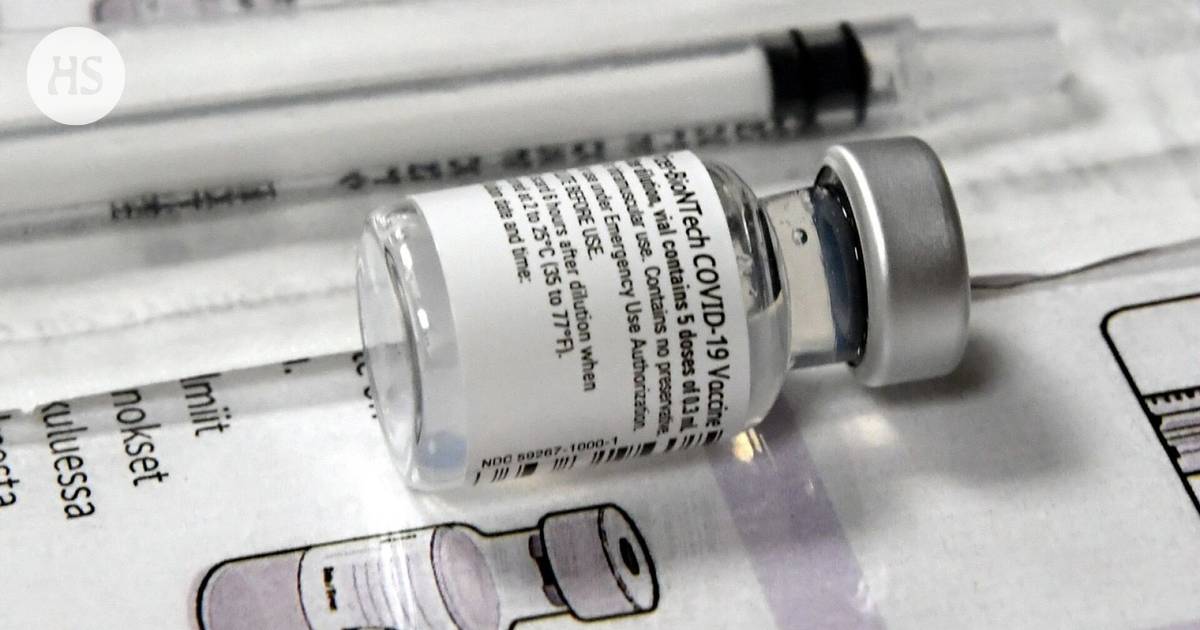
 www.hs.fi
www.hs.fi
Tämä juttu ei tietenkään ole kohdistettu rokotehörhöille, vaan enemmän niille, joita kiinnostaa faktat mutta joille syystä tai toisesta ne faktat on jäänyt tämän 1,5v aikana kuulematta tai ymmärtämättä:

Koronafaktaa | Rna-rokote on rokote, vaikka rokotevastustajat muuta väittäisivät
Lopputulos on sama kuin perinteisemmissä rokotteissa.
- Liittynyt
- 17.10.2016
- Viestejä
- 10 477
Ei moderaattoreita kiinnosta vääntäminen, kysyin heidän mielipidettä tähän.Ei tätä vastustamista ole vaan suunniteltu sillä mielellä, että muut tarkistavat esittämäsi väitteet.
Kun vaan saisi moderaattorin hetkeksi seuraamaan tätä mustan valkoiseksi vääntämistä ...
- Liittynyt
- 17.10.2016
- Viestejä
- 3 661
Väitän silti, ettei tuossa ollut mitään rokotevastaista. Lähes kaikkien kappaleiden lopussa on ollut jokin linkki lähteeseen, joten kirjoitukset eivät käytännössä ole edes hänen itsensä keksimiä.
Tuo kohta johon tartuit oli kai tästä kappaleesta:
ROKOTE JA TAUDIN LEVIÄMINEN
Estääkö rokottaminen taudin leviämistä? Vastikään julkaistun korkea-arvoisen lehden julkaisu ei tue tätä väitettä. Tutkimuksessa käytiin läpi 68 valtiota ja 2947 maakuntaa Yhdysvalloissa eikä rokote näytä estävän koronan leviämistä. Tämäkään ei näytä olevan peruste rokotteeseen pakottamiselle.
On ajateltu, että rokotettu levittäisi tautia lyhyemmän aikaa, mutta tämä tutkimus ei ainakaan osoita sillä olevan epidemiologisesti merkitystä. Increases in COVID-19 are unrelated to levels of vaccination across 68 countries and 2947 counties in the United States | SpringerLink
Läpäisyinfektiot – miksi rokotetutkin voivat saada koronavirustartunnan? (duodecimlehti.fi)
Ja se perustui tähän tutkimukseen:
"At the country-level, there appears to be no discernable relationship between percentage of population fully vaccinated and new COVID-19 cases in the last 7 days (Fig. 1). In fact, the trend line suggests a marginally positive association such that countries with higher percentage of population fully vaccinated have higher COVID-19 cases per 1 million people."
Olisi tuohon kyllä sopinut tarkennus, että hän puhuu maakohtaisesta väestöstä. Tosin jos tuon kirjoituksen linkit olisivat olleet elossa, niin jokainen olisi voinut ne avata ja olla ymmärtämättä väärin.
On tuossa nyt vähän enemmänkin vialla.
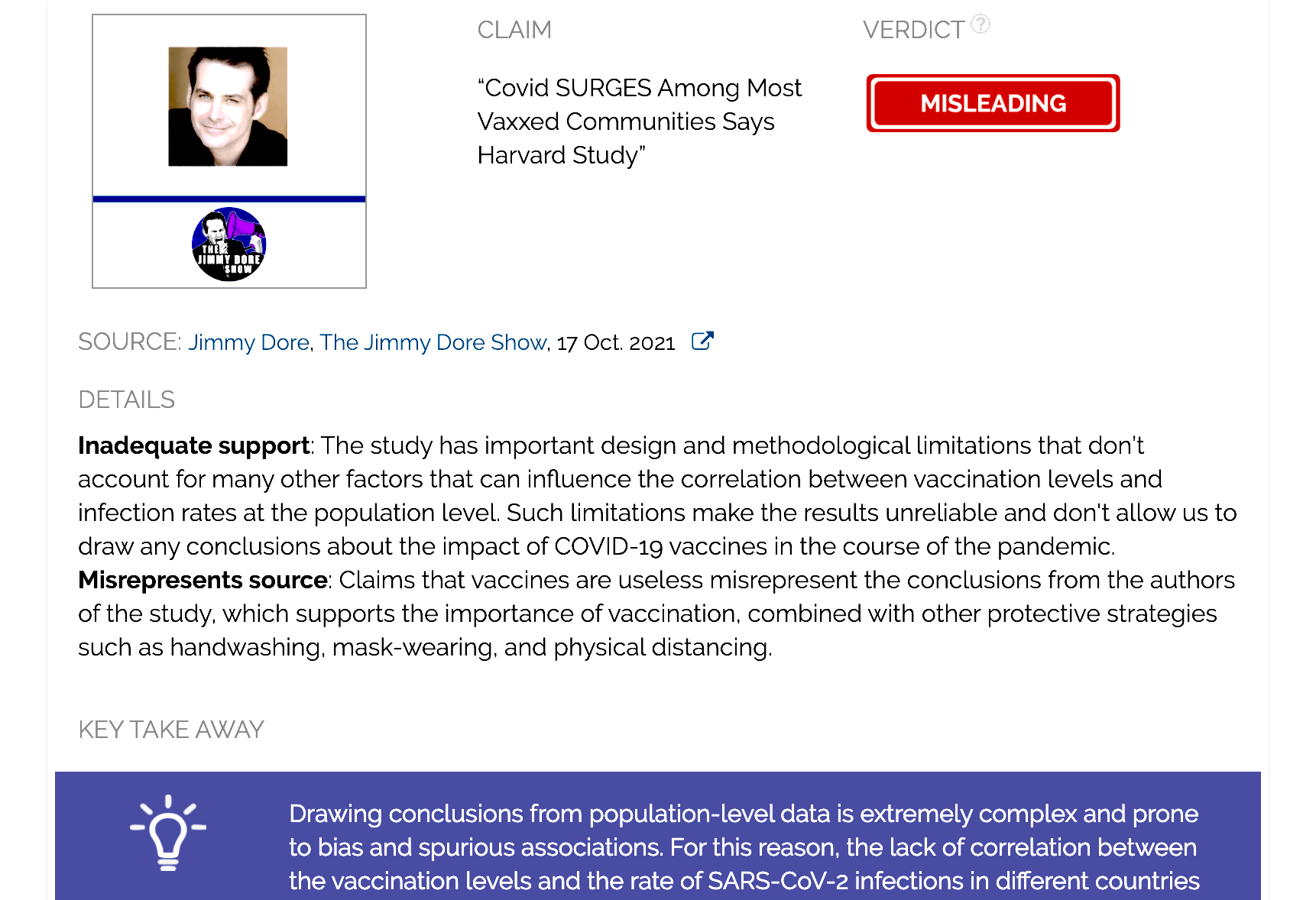
Claims that a Harvard study showed COVID-19 vaccines are ineffective misrepresent the authors’ conclusions, fail to account for the study’s limitations - Science Feedback
Drawing conclusions from population-level data is extremely complex and prone to bias and spurious associations. For this reason, the lack of correlation between the vaccination levels and the rate of SARS-CoV-2 infections in different countries and regions can’t be interpreted as evidence that...
Kuten tuosta jutusta ilmenee niin tämä "korkea-arvoisen lehden julkaisu" siis on itseasiassa geologian tohtorin ja lukio-opiskelijan kirjoittama lyhyt tutkimusselostus ja jos pyrkii älylliseen rehellisyyteen niin ei poimi tuommoista väestötason tarkastelua jossa on paljon muitakin muuttujia ainoaksi viitteekseen ja sitten keskity vaan tohon nojautuen heittämään epäilyksen varjoa ilman että esittää varsinaisesti minkäänlaisia väitteitä.
Periaatteessa kyllä mutta se estää myös tartuntoja, mitä kautta se suojaa "laumaa" tehokkaammin, mitä useampi sen on ottanut.Eikös koronarokotteen tärkein tehtävä on estää vakavaa tautimuotoa ja sitä kautta vähentää sairaalakuormitusta. Jos täysin rokotettu saa koronatartunnan niin tauti on yleensä lievä ja immuniteetti vain kasvaa.
- Liittynyt
- 18.10.2016
- Viestejä
- 950
Itsellä omakohtaista kokemusta että 2 rokotetta saattaa tosiaan ehkäistä sitä tartuntaa myös aika tehokkaasti. 9v Korona positiivisen pojan kanssa yksiössä 10 vrk ja siihen päälle pari aivastusta suoraan naamaan eikä itselle tullut mitään. Toki en itse ikinä käynyt testissä joten voi olla että tarttuikin mutta tässä tapauksessa oli sitten täysin oireeton.
Jos en tuosta saanut koronaa niin en sitä kyllä saa sitten mistään.
Jos en tuosta saanut koronaa niin en sitä kyllä saa sitten mistään.
Tuo on Israelin ja Tanskan osalta ammuttu alas. Tänne oli jo linkattu keltaisenlehdistön juttua Tanskasta missä 18v täyttäneillä kattavuus hipoo 90% ja sairaalat jutun mukaan täyttyy vaan. Pääasia että rokotefirmojen kurssit ei tule rommaamaan vähään aikaan, kun puolenvuoden sisään jo 3 rokotetta on meille myös tarjottu.Periaatteessa kyllä mutta se estää myös tartuntoja, mitä kautta se suojaa "laumaa" tehokkaammin, mitä useampi sen on ottanut.
- Liittynyt
- 17.10.2016
- Viestejä
- 10 477
Israelissa ja tanskassa rokottamattomat sairastavat ja täyttävät sairaalat. Samoin suomessa, virossa, saksassa, briteissä jne. Rokotetut sairastavat sen lievänä flunssana tai nuhana.Tuo on Israelin ja Tanskan osalta ammuttu alas. Tänne oli jo linkattu keltaisenlehdistön juttua Tanskasta missä 18v täyttäneillä kattavuus hipoo 90% ja sairaalat jutun mukaan täyttyy vaan. Pääasia että rokotefirmojen kurssit ei tule rommaamaan vähään aikaan, kun puolenvuoden sisään jo 3 rokotetta on meille myös tarjottu.
Oletko yllättynyt..?
Valitan jos olet saanut sellaisen käsityksen mitä en ole kirjoittanut. Järjestelmä ei ollut turvallinen, eikä siihen oltu ennakkoon varauduttu. Lisäksi väärinkäyttö tapahtui mielestäni ajateltua nopeammin. Toki on ollut mahdollisuus ottaa avaimia pois käytöstä, mutta vähän ongelmallista poistaa esim. maakohtaiset avaimet kokonaan, koska silloin kaikkien sen maan kansalaisten passit lakkaisivat toimimasta. Aika huono varautumissuunnitelma. Aika pitkään tuo Adolf Hitlerin passikin on kelvannut, vaikka väärennös on tunnistettu.
Järjestelmä on turvallinen ihan kuten esim. potilastietojärjestelmäkin on. Väärinkäytöksistä jää kiinni, mutta aina näitä löytyy jotka väärinkäyttävät. Suomessakin paljastuu aina välillä terveydenhuollossa sekä poliisissa näitä. Ei tämä nyt vaikeata ole, tehdään uudella avaimella olevat passit ensin ja sitten poistetaan ne vanhat avaimet. Väärinkäytöksiin syyllistyneet saavat siitä kuuluvat rangaistukset. En näe mitään suurta ongelmaa järjestelmän kanssa. Se, että on yksittäisiä koronapasseja, jotka kelpaavat tovin vaikka ei pitäisi ei ole mikään ongelma kun puhutaan kuitenkin yksittäistapauksista.
Tuo on Israelin ja Tanskan osalta ammuttu alas. Tänne oli jo linkattu keltaisenlehdistön juttua Tanskasta missä 18v täyttäneillä kattavuus hipoo 90% ja sairaalat jutun mukaan täyttyy vaan. Pääasia että rokotefirmojen kurssit ei tule rommaamaan vähään aikaan, kun puolenvuoden sisään jo 3 rokotetta on meille myös tarjottu.
"Sairaalat täyttyy" on osa "en ole mikään antivaxxeri mutta" -retoriikkaa. Täyttyyhän ne, ekasta potilaasta alkaen

Tanskassa on ollut 1,5 kuukautta täysin rajoituksesta vapaata. Tanskalaisia on enemmän kuin suomalaisia ja he asuvat erittäin paljon tiiviimmin. Silti Tanskassa on selvästi vähemmän väkeä sairaalassa ja teho-osastolla.
Selitys?
Tanskassa on rokotteet edellä Suomea.
Misinformaation levittäminen
97% Suomessakin sairastanut koronan lievänä tai jopa oireettomana.Israelissa ja tanskassa rokottamattomat sairastavat ja täyttävät sairaalat. Samoin suomessa, virossa, saksassa, briteissä jne. Rokotetut sairastavat sen lievänä flunssana tai nuhana.
Oletko yllättynyt..?
Oletko siihen yllättynyt tai tietämätön?
- Liittynyt
- 17.10.2016
- Viestejä
- 10 477
Ei ole sairastanut., mutta jos sinulla on faktatieto tästä niin laitatko tänne nähtäville linkin siitä.97% Suomessakin sairastanut koronan lievänä tai jopa oireettomana.
Oletko siihen yllättynyt tai tietämätön?
Miksi käytät aikaa internetissä valehteluunTuo on Israelin ja Tanskan osalta ammuttu alas. Tänne oli jo linkattu keltaisenlehdistön juttua Tanskasta missä 18v täyttäneillä kattavuus hipoo 90% ja sairaalat jutun mukaan täyttyy vaan. Pääasia että rokotefirmojen kurssit ei tule rommaamaan vähään aikaan, kun puolenvuoden sisään jo 3 rokotetta on meille myös tarjottu.
- Liittynyt
- 22.12.2016
- Viestejä
- 22 171
Toi voi pitääkin paikkaansa, jos sana "lievä" venytetään ihan äärimmilleen ja sillä tarkoitetaan kaikkea muuta sairastamista paitsi sairaalan/tuonelan porteille johtavaa...97% Suomessakin sairastanut koronan lievänä tai jopa oireettomana.
Oletko siihen yllättynyt tai tietämätön?
Missä kohtaa valehtelin? Tuossa Tanskan kohdalla ehkä vähättelin 90%.Miksi käytät aikaa internetissä valehteluun
Euroopan kärkimaa on Tanska, jossa peräti 95,2 prosenttia yli 18-vuotiaista on saanut molemmat rokoteannokset. Myös Irlannissa, Islannissa, Maltassa ja Portugalissa yli 18-vuotiaiden rokotuskattavuus on yli 90 prosentin.
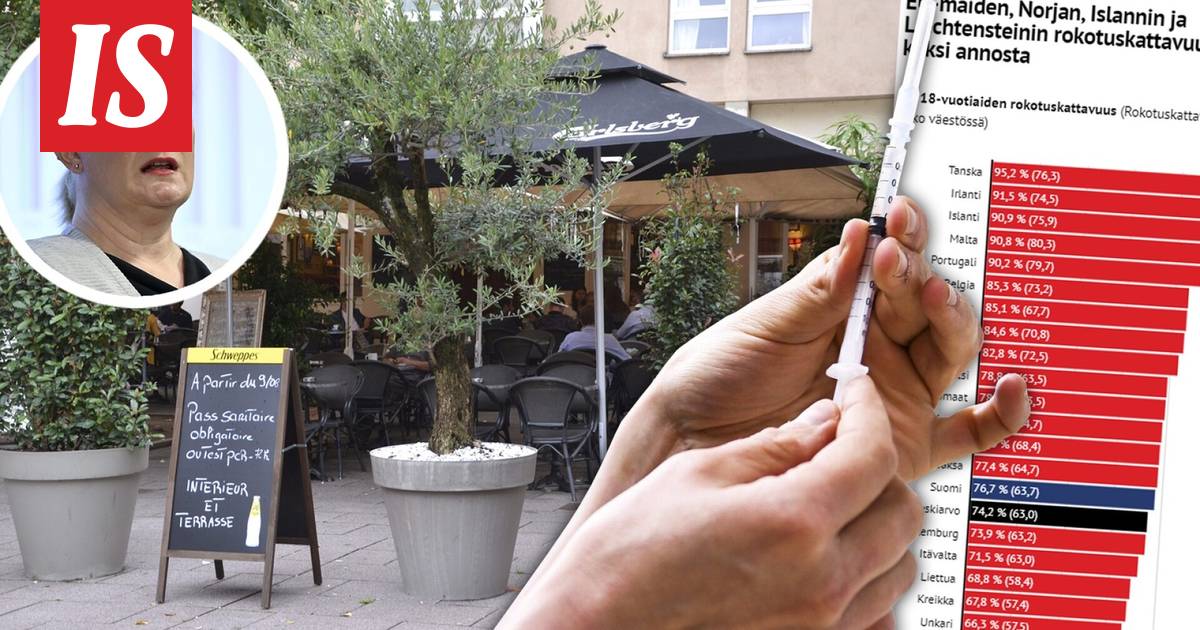
Rokotustahti lässähti ja nyt moni Euroopan maa tekee selvää eroa Suomeen – asiantuntija kertoo miksi
Moni Länsi- ja Etelä-Euroopan maa on näyttänyt Suomelle perävaloja rokotuskattavuudessa.
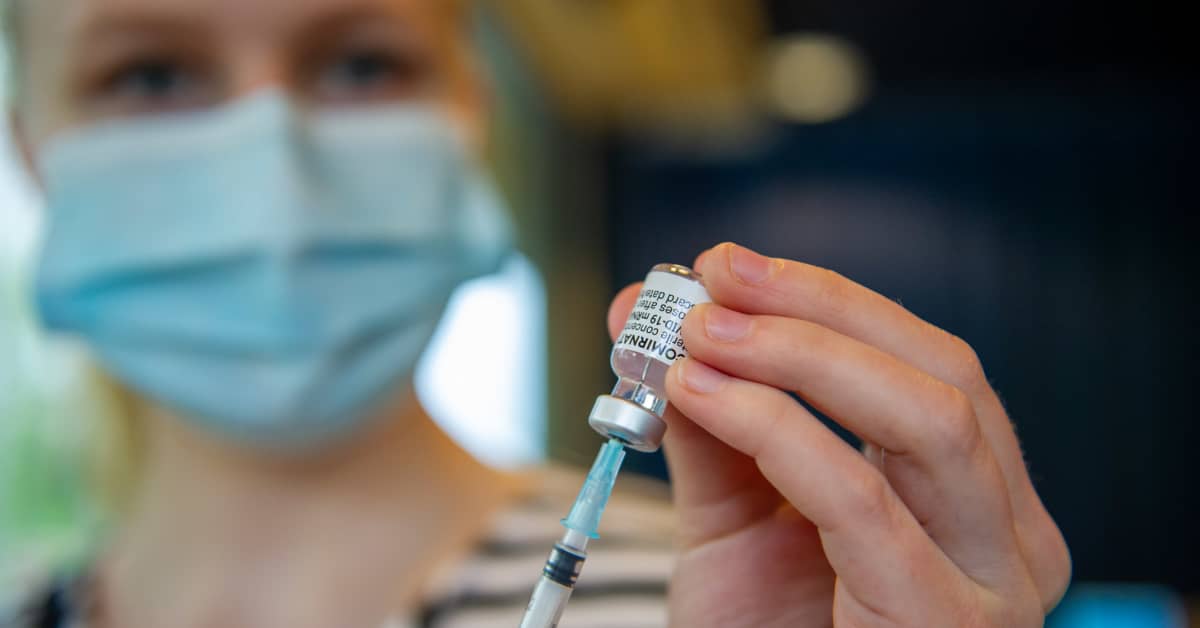
THL ohjeistaa kuntia kolmansien koronarokotteiden antamiseen – HUSin alueella ja Varsinais-Suomessa alkaa kolmas rokotuskierros
Terveyden ja hyvinvoinnin laitos ohjeistaa kuntia tarjoamaan kolmatta koronarokotusta niille 12 vuotta täyttäneille, joiden elimistön immuunivaste on taudin tai sen hoidon vuoksi voimakkaasti madaltunut. HUS päätti asiasta yhdessä kuntien kanssa torstaina.
Missä kohtaa valehtelin?
Vääristit koko tilanteen niin päin, että rokotteista huolimatta siellä menisi jotenkin huonosti kun totuus on, että siellä on kaikki edellytykset Suomea paljon huonommalle tilanteelle PAITSI ne rokotukset ja silti suhteellinen hoitotarve on huomattavasti Suomea alhaisempi.
Eiköhä kaikki jo osaa tän pelin. Kukaan rokotevastustaja ei enää jaksa valehdella suoraan, siitä kun tulee bannit helposti. Sen sijaan tätä epämääräistä lähteiden väärin esittämistä ja annetaan ymmärtää, että ne kertoisi jotain ihan muuta kuin todellisuudessa kertovat ja sitten toivotaan kovaa, ettei kukaan jaksa tarkistaa niitä ja oikaista täällä.
ps. Siellä ei sairaalat "täyty" siinä mielessä, että olisivat lähes täynnä
Viimeksi muokattu:
Huomautus - jätä hyökkäävä ja väheksyvä sävy pois keskustelusta
Kyllä sinun kapasiteetillasi kykenee tämän itsekin päättelemään kunhan et tahallaan heittäydy tietämättömäksi tai usko hörhöjen propagandaa kritiikittäMissä kohtaa valehtelin? Tuossa Tanskan kohdalla ehkä vähättelin 90%.
Euroopan kärkimaa on Tanska, jossa peräti 95,2 prosenttia yli 18-vuotiaista on saanut molemmat rokoteannokset. Myös Irlannissa, Islannissa, Maltassa ja Portugalissa yli 18-vuotiaiden rokotuskattavuus on yli 90 prosentin.
3 rokotetta tarjottu.
Rokotustahti lässähti ja nyt moni Euroopan maa tekee selvää eroa Suomeen – asiantuntija kertoo miksi
Moni Länsi- ja Etelä-Euroopan maa on näyttänyt Suomelle perävaloja rokotuskattavuudessa.www.is.fi

THL ohjeistaa kuntia kolmansien koronarokotteiden antamiseen – HUSin alueella ja Varsinais-Suomessa alkaa kolmas rokotuskierros
Terveyden ja hyvinvoinnin laitos ohjeistaa kuntia tarjoamaan kolmatta koronarokotusta niille 12 vuotta täyttäneille, joiden elimistön immuunivaste on taudin tai sen hoidon vuoksi voimakkaasti madaltunut. HUS päätti asiasta yhdessä kuntien kanssa torstaina.yle.fi
- Liittynyt
- 16.10.2016
- Viestejä
- 624
Tanskassa on 28 potilasta tehohoidossa ja Suomessa 31 joten en puhuisi selvästä erosta."Sairaalat täyttyy" on osa "en ole mikään antivaxxeri mutta" -retoriikkaa. Täyttyyhän ne, ekasta potilaasta alkaen
Tanskassa on ollut 1,5 kuukautta täysin rajoituksesta vapaata. Tanskalaisia on enemmän kuin suomalaisia ja he asuvat erittäin paljon tiiviimmin. Silti Tanskassa on selvästi vähemmän väkeä sairaalassa ja teho-osastolla.
Selitys?
Tanskassa on rokotteet edellä Suomea.
- Liittynyt
- 19.10.2016
- Viestejä
- 4 565
Tanskassa on 28 potilasta tehohoidossa ja Suomessa 31 joten en puhuisi selvästä erosta.
Entä mitä mieltä olet asukastiheydestä ja sen vaikutuksesta?
- Liittynyt
- 26.10.2016
- Viestejä
- 7 597
Myös tämä meidän sijainti euroopan viimeisenä peräkylänä näyttäisi auttavan meitä aika paljon tässä tilanteessa.Entä mitä mieltä olet asukastiheydestä ja sen vaikutuksesta?
- Liittynyt
- 17.10.2016
- Viestejä
- 10 477
Vähän kaikessa kun väitit että 97% suomessa on sairastaneet koronan.Missä kohtaa valehtelin? Tuossa Tanskan kohdalla ehkä vähättelin 90%.
Euroopan kärkimaa on Tanska, jossa peräti 95,2 prosenttia yli 18-vuotiaista on saanut molemmat rokoteannokset. Myös Irlannissa, Islannissa, Maltassa ja Portugalissa yli 18-vuotiaiden rokotuskattavuus on yli 90 prosentin.
3 rokotetta tarjottu.
Rokotustahti lässähti ja nyt moni Euroopan maa tekee selvää eroa Suomeen – asiantuntija kertoo miksi
Moni Länsi- ja Etelä-Euroopan maa on näyttänyt Suomelle perävaloja rokotuskattavuudessa.www.is.fi

THL ohjeistaa kuntia kolmansien koronarokotteiden antamiseen – HUSin alueella ja Varsinais-Suomessa alkaa kolmas rokotuskierros
Terveyden ja hyvinvoinnin laitos ohjeistaa kuntia tarjoamaan kolmatta koronarokotusta niille 12 vuotta täyttäneille, joiden elimistön immuunivaste on taudin tai sen hoidon vuoksi voimakkaasti madaltunut. HUS päätti asiasta yhdessä kuntien kanssa torstaina.yle.fi
- Liittynyt
- 17.10.2016
- Viestejä
- 13 636
No ainakin jälkimmäinen ei ole tutkimus ollenkaan, vaan pelkkää mutuilua ilman yhtään datapistettä.Mielenkiintoisia tutkimuksia

Covid-19: Do many people have pre-existing immunity?
It seemed a truth universally acknowledged that the human population had no pre-existing immunity to SARS-CoV-2, but is that actually the case? Peter Doshi explores the emerging research on immunological responses Even in local areas that have experienced some of the greatest rises in excess...www.bmj.com
Tässä pohdittiin toksikologian ja immuniteetin kautta mm oireiden vakavuutta ja ilmaantumista
It is clear from the SARS results and the present COVID-19 results that exposure to the coronavirus for most people (except the relatively small number in the most vulnerable demographic) results in relatively mild symptoms (or, in many cases, no symptoms). In other words, the vast majority of the public is metaphorically being protected presently by an extremely effective “quasi-vaccine”; namely, following practices that, while they certainly degrade the immune system to some extent because of exposure to toxic stressors, do not degrade the immune system excessively. Promoting healthy lifestyle habits (including healthy diet, regular aerobic exercise, and appropriate responses to adverse life events) and an ambitious regulation of toxic stressors (chemicals, radiations, etc.) are cornerstones to reducing the risk of developing most chronic diseases. These healthy habits represent a “quasi-vaccine” as they are capable of eliminating those factors that contribute to degrading the immune system and adding those factors that contribute to strengthening the immune system. For most of the public, this “quasi-vaccine” has proven to be effective, and further elimination of immune-degrading contributing factors will improve the immune system further and afford even greater protection from infectious diseases.
The underlying causes of the present pandemic have been both misrepresented and camouflaged. Causes that are mainly toxicology-based have been ignored relative to virology-based causes. This has resulted in treatments and ‘protective’ measures that address virology issues to the exclusion of toxicology issues, are of questionable effectiveness, and do little (if anything) to prevent future pandemics. They have produced disastrous effects on the global economy that have worsened social and economic conditions of many people and contributed to a deterioration of their physical and mental health. To correct this situation, and offer intrinsic protection against future pandemics, both tactical/reactive responses to survive the immediate threat and strategic/proactive responses to prevent the problem and damage from re-occurring are required.

The under-reported role of toxic substance exposures in the COVID-19 pandemic
Coronavirus disease 2019 (COVID-19) and previous pandemics have been viewed almost exclusively as virology problems, with toxicology problems mostly b…www.sciencedirect.com
Tanskassa on 28 potilasta tehohoidossa ja Suomessa 31 joten en puhuisi selvästä erosta.
Ottaen huomioon tanskalaisten (hieman) suuremman väestön, huomattavasti korkeamman väestötiheyden, 2-3 -kertaiset tartuntaluvut päivässä, puolitoista kuukautta täysin ilman rajoituksia jne. sanoisin eron olevan huomattava. Tanskassa luulisi olevan heittäen 5-kertainen määrä sairaalapotilaita Suomeen verrattuna.
Ainoa, mikä selittää Tanskan sairaaloiden paremman tilanteen taitaa olla... noh, kyllä sä tiedät, vaikket halua myöntää - rokotusaste.
Itseasiassa jutun lopussa tanskalainen lääkäri toteaa Tanskan tilanteesta kirjaimellisesti kyseessä olevan rokottamattomien epidemia. Ajatella
Nimenomaan toteaa. Samaa noitavainoa täällä alkaa olemaan! olkoot vaikka 5% enää rokottamattomia, niin sama panikointi ja hysteeriaa ilmassa. Eikö rokotetuilla ole luottoa piikin tehoon, vai mikä mättää, kun Suomessakin toteutuu yli 80% KATTAVUUS 2 piikissä ensi viikolla. Seuraava steppi on alkaa hokemaan sitä 3 piikkiä jne..Ottaen huomioon tanskalaisten (hieman) suuremman väestön, huomattavasti korkeamman väestötiheyden, 2-3 -kertaiset tartuntaluvut päivässä, puolitoista kuukautta täysin ilman rajoituksia jne. sanoisin eron olevan huomattava. Tanskassa luulisi olevan heittäen 5-kertainen määrä sairaalapotilaita Suomeen verrattuna.
Ainoa, mikä selittää Tanskan sairaaloiden paremman tilanteen taitaa olla... noh, kyllä sä tiedät, vaikket halua myöntää - rokotusaste.
Itseasiassa jutun lopussa tanskalainen lääkäri toteaa Tanskan tilanteesta kirjaimellisesti kyseessä olevan rokottamattomien epidemia. Ajatella
Nimenomaan toteaa. Samaa noitavainoa täällä alkaa olemaan! olkoot vaikka 5% enää rokottamattomia, niin sama panikointi ja hysteeriaa ilmassa. Eikö rokotetuilla ole luottoa piikin tehoon, vai mikä mättää, kun Suomessakin toteutuu yli 80% KATTAVUUS 2 piikissä ensi viikolla. Seuraava steppi on alkaa hokemaan sitä 3 piikkiä jne..
Ketään ei kiinnosta rokottamattomien kärsimykset vaan se, että heitä on Suomessa suhteessa liikaa (enemmän kuin Tanskassa), josta seuraa, ettei sairaanhoitopaikkoja (ehkä) riitä.
- Liittynyt
- 22.12.2016
- Viestejä
- 22 171
Teknisesti ottaen toi 80% kattavuuskaan ei edes toteudu, kun otetaan koko väestö huomioon kuten pitäisi. Toi 80% saadaan toteutumaan vain kun siirretään tolppia sillä tavalla mukavasti että alle 12-vuotiaat jätetään kokonaan yhtälön ulkopuolelle.Nimenomaan toteaa. Samaa noitavainoa täällä alkaa olemaan! olkoot vaikka 5% enää rokottamattomia, niin sama panikointi ja hysteeriaa ilmassa. Eikö rokotetuilla ole luottoa piikin tehoon, vai mikä mättää, kun Suomessakin toteutuu yli 80% KATTAVUUS 2 piikissä ensi viikolla. Seuraava steppi on alkaa hokemaan sitä 3 piikkiä jne..
Vaikka rokote onkin hyvä, niin ei se riitä jos joukossamme liikkuu liian paljon rokottamattomia.
- Liittynyt
- 17.10.2016
- Viestejä
- 10 477
Rokotetuilla on luottoa siihen, siksi rokotettuja on jo hyvä määrä. Sen sijaan rokottamattomilla hörhöillä on pelko tai muu tekosyy itse rokotteeseen. Ei ole oikeaa syytä olla ottamatta sitä ilmaista valtion kustantamaa piikkiä.Nimenomaan toteaa. Samaa noitavainoa täällä alkaa olemaan! olkoot vaikka 5% enää rokottamattomia, niin sama panikointi ja hysteeriaa ilmassa. Eikö rokotetuilla ole luottoa piikin tehoon, vai mikä mättää, kun Suomessakin toteutuu yli 80% KATTAVUUS 2 piikissä ensi viikolla. Seuraava steppi on alkaa hokemaan sitä 3 piikkiä jne..
Ei se ole niin vaikeaa ymmärtää.
Eipä se varmastikaan siitä luotosta ole kiinni. Mut kyl se vähän pistää harmittaan, että sairaaloissa on täysin turhaa ylikuormaa mikä olis suurimmilta osin vältettävissä ottamalla piikin olkavarteen.Nimenomaan toteaa. Samaa noitavainoa täällä alkaa olemaan! olkoot vaikka 5% enää rokottamattomia, niin sama panikointi ja hysteeriaa ilmassa. Eikö rokotetuilla ole luottoa piikin tehoon, vai mikä mättää, kun Suomessakin toteutuu yli 80% KATTAVUUS 2 piikissä ensi viikolla. Seuraava steppi on alkaa hokemaan sitä 3 piikkiä jne..
Tai korkinkiinni laittamalla, tupakoinnin lopettamalla, sähköpotkulautojen kieltämisellä yms.Eipä se varmastikaan siitä luotosta ole kiinni. Mut kyl se vähän pistää harmittaan, että sairaaloissa on täysin turhaa ylikuormaa mikä olis suurimmilta osin vältettävissä ottamalla piikin olkavarteen.
Uutiset
-
Live: io-techin Tekniikkapodcast (50/2025)
12.12.2025 14:07
-
Asus julkisti 5K-resoluution ROG Strix 5K XG27JCG -pelinäytön huippuominaisuuksilla
12.12.2025 00:00
-
Google myöntää näyttöongelmista kärsiville Pixel 9 Pro- ja Pro XL -älypuhelimille pidennetyn takuun
11.12.2025 17:41
-
AMD julkaisi tekoälypohjaiset FSR ”Redstone” -teknologiat
10.12.2025 23:04
-
AMD julkaisi AMD Software 25.12.1-ajurit näytönohjaimilleen ja prosessoreilleen
10.12.2025 21:30

